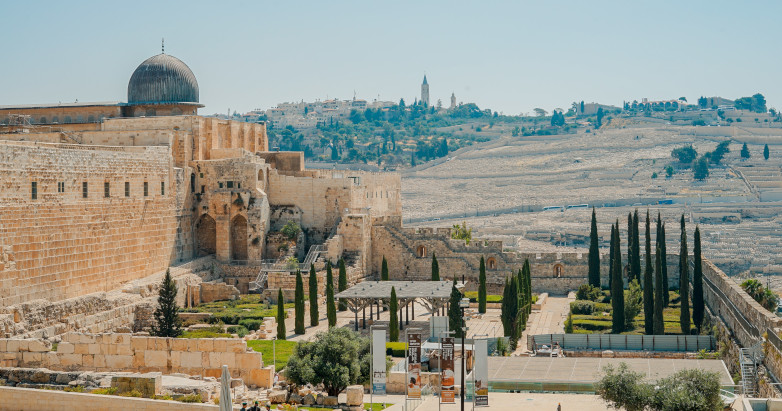
Jesus’ conversation with the Samaritan woman at the well in John 4 is one of the most famous passages in the New Testament. As we might expect with any passage so famous, dozens of interpretations have been offered throughout church history for what the passage might mean, and how we might apply it.
I too have dabbled in this in the past. A few months ago, for example, I argued that the scene at the well is a betrothal scene—John is painting Jesus as the ultimate husband for which the woman has been desperately searching. But I don’t think Jesus-as-spiritual-husband is the only biblical theme being picked up in this story.
In fact, I think the story has a lot to say about the biblical conception of the temple. Specifically, I think it deals with believers being the temple of the Holy Spirit. And it contains a dramatic assertion by Jesus that the Samaritan woman will become a temple in which God’s spirit will dwell. Let me show you what I mean.
A Spring of Living Water
To see the “temple of the Holy Spirit” theme in John 4, we need to start by looking at Jesus’ offer of living water to the Samaritan woman. Here’s what Jesus says about that water in verses 13-14.
Everyone who drinks of this water [in the well] will be thirsty again, but whoever drinks of the water that I will give him will never be thirsty again. The water that I will give him will become in him a spring of water welling up to eternal life.
Of course, John 4 never records for us exactly what this all means. What is the living water that Jesus is talking about? How will he give it? And how will it well up to eternal life? It’s all a bit mysterious.
But if we continue reading in John’s gospel, we find that only a few chapters later, Jesus starts talking about living water again. And, this time, John gives us an explanation of what Jesus means. Here’s John 7:37-38.
On the last day of the feast, the great day, Jesus stood up and cried out, “If anyone thirsts, let him come to me and drink. Whoever believes in me, as the Scripture has said, ‘Out of his heart will flow rivers of living water.’” Now this he said about the Spirit, whom those who believed in him were to receive, for as yet the Spirit had not been given, because Jesus was not yet glorified.
We might recognize some slight differences in the imagery (a spring of living water, vs. a river of living water flowing out of a person). But overall, it’s undeniable that Jesus is talking about the same idea here that he was with the Samaritan woman. And John’s interpretation makes it clear that he’s talking about the Holy Spirit coming to dwell in God’s people.
Temples and Rivers of Living Water
But there’s more that we can say about this imagery than just that it deals with the Holy Spirit. We must also recognize that the idea of living water flowing out of something is deeply connected to biblical imagery surrounding the temple.
In fact, notice what Jesus says in the John 7 text right before he talks about rivers of living water: “as the Scripture has said.” Jesus didn’t come up with this idea on his own! He’s referencing the Jewish scriptures.
According to New Testament scholar G.K. Beale, this reference by Jesus doesn’t seem to be a direct quote, but rather a composite allusion to prophecies concerning the temple in Ezekiel, Joel, and Zechariah.
Consider, for example, that Ezekiel spends entire chapters describing a restored Israel and restored temple in minute detail. And here’s what he says about the temple, in Ezekiel 47:1-12 (I’m shortening this quote to save space, but I’d recommend reading the full passage).
Then he brought me back to the door of the temple, and behold, water was issuing from below the threshold of the temple toward the east… And he said to me, “…wherever the river goes, every living creature that swarms will live… so everything will live where the river goes… And on the banks, on both sides of the river, there will grow all kinds of trees for food. Their leaves will not wither, nor their fruit fail, but they will bear fresh fruit every month, because the water for them flows from the sanctuary. Their fruit will be for food, and their leaves for healing.”
This is a vision of water, flowing out from the restored temple, and bringing life to everything it touches! And it’s quite similar to Joel’s prophecy about a “fountain coming forth from the house of the Lord” (Joel 3) and Zechariah’s vision of “living waters flowing out from Jerusalem” (where the temple was located, Zechariah 14).
Jerusalem? Or Mount Gerizim?
So far, we’ve seen that “living water” is used very explicitly in John to refer to the Holy Spirit. And we’ve seen, further, that springs/rivers of living or life-giving water are frequently used in biblical conceptions of the temple. We therefore have reason to suspect that, when Jesus offers “living water” to the Samaritan woman, he’s suggesting that she herself can become the temple of the Holy Spirit, and he can dwell within her.
But there’s one last bit of evidence we need to see to bring this idea full circle: the conversation between Jesus and the Samaritan woman about where people ought to worship. Here’s what they say in John 4:19-24.
The woman said to him, “Sir, I perceive that you are a prophet. Our fathers worshiped on this mountain, but you say that in Jerusalem is the place where people ought to worship.”
Jesus said to her, “Woman, believe me, the hour is coming when neither on this mountain nor in Jerusalem will you worship the Father. You worship what you do not know; we worship what we know, for salvation is from the Jews. But the hour is coming, and is now here, when the true worshipers will worship the Father in spirit and truth, for the Father is seeking such people to worship him. God is spirit, and those who worship him must worship in spirit and truth.”
The woman asks Jesus whether it’s correct to worship in Jerusalem (the site of the Jewish temple) or Mount Gerizim (the site of the Samaritan temple). And Jesus says that, very soon, people won’t worship at either place.
Why? Because God’s spirit, which formerly dwelt exclusively in the temple, will soon dwell in individual believers, as Jesus’ offer of living water suggests!
Temples… and Brides?
In John 4, Jesus is teaching the Samaritan woman about the coming of the Holy Spirit, to dwell in believers just as God’s spirit formerly dwelt in the temple. But, as I’ve argued previously, there’s also strong reason to think that John also intends to use the story to portray Jesus as the ultimate bridegroom. In other words, I suspect that John 4 is using themes of both temple and marriage to describe God’s relationship with his people.
But is there anywhere else in scripture where we see this happen? The answer is yes—and the other references are quite clear.
Consider, for example, Revelation 21-22. The heavenly New Jerusalem is revealed as “the Bride, the wife of the Lamb.” It is God’s people, made perfect by his redeeming love, now come to be with him forever. A loud voice from the throne announces that the “dwelling place of God is with man.” And the description of the city echoes almost exactly Ezekiel’s vision of a restored temple… a river of the water of life flows from the city, the tree of life grows on its banks, and its leaves are for the healing of the nations, just as Ezekiel described.
Whether John the Apostle wrote Revelation is, of course, a subject of historical debate. But, assuming for a second that he did, this passage in Revelation shows remarkable similarity to the thematic interpretations I’ve suggested in John 4. Christ as the groom and his people as the bride. God dwelling in the midst of his people. The temple. Rivers of life-giving water. It’s all there, in both passages!
Moreover, we also see the themes of Christ as spiritual husband and the temple of the Holy Spirit clearly held together in 1 Corinthians 6:12-20. And I’ll talk about that passage more in a future post.
Conclusion
I hope that I’ve been able to demonstrate that Jesus’ conversation with the Samaritan woman in John 4 uses imagery related to the Holy Spirit and the temple to imply that the Holy Spirit will one day come to dwell in believers, as they themselves become God’s temple.
If you’ve got questions or thoughts on this interpretation of John 4, I’d love to hear them. Please scroll down and leave a comment below, or you can also reach out on Twitter.
Also, as those who’ve been following some of my writing will know, I’m ultimately seeking to recover a biblical understanding of the idea of “sexual purity” and I’ve argued that it has a lot to do with the biblical theme of God and his people as bride and groom. In a future post, I intend to continue exploring how the ideas of temple, cleansing, and marriage come together in biblical passages touching on sexual ethics (including 1 Corinthians 6 and, yes, John 4). Please come back if you want to see where these thoughts lead!
Finally, I should point out that I’m indebted to G.K. Beale and, to a lesser extent, John Walton for many of the ideas concerning temple in today’s post. Beale’s The Temple and the Church’s Mission is a fantastic biblical theology of temple, which I highly recommend to those interested in learning more about these themes. Moreover, his The Story Retold is a great resource for those seeking to understand how the New Testament develops and makes use of Old Testament ideas. I give him credit for influencing my thinking, and I highly recommend both books to those interested in learning more!












